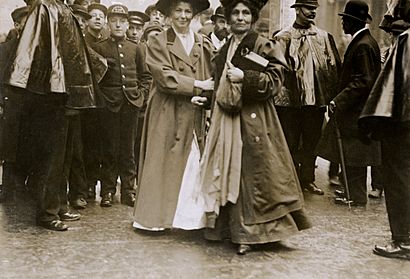Battle of Downing Street facts for kids
Quick facts for kids Battle of Downing Street |
|||
|---|---|---|---|

Christabel and Emmeline Pankhurst, 1910
|
|||
| Date | 22 November 1910 | ||
| Location |
Downing Street, London, England
51°30′11.6″N 0°07′39.0″W / 51.503222°N 0.127500°W |
||
| Methods | Demonstration, smashing windows | ||
| Parties to the civil conflict | |||
|
|
|||
| Lead figures | |||
|
|
|||
| Number | |||
|
|||
| Arrests | |||
| Arrested | 159 women; three men | ||
| Preceded by: Black Friday | |||
The Battle of Downing Street was a protest march by suffragettes in London, England. It happened on November 22, 1910. The suffragettes were women who fought for the right to vote. This march was organized by the Women's Social and Political Union (WSPU), led by Emmeline Pankhurst. It took place just four days after an earlier protest called Black Friday. During Black Friday, suffragettes protesting outside the House of Commons were treated very roughly by the police.
Why Did the Suffragettes March?
This protest was part of a bigger fight for women's voting rights. At the time, a law called the Conciliation Bill 1910 was being discussed. This bill would have given some women the right to vote, based on their property or marital status.
The Prime Minister, H. H. Asquith, made a statement about the bill. He said the government would only help pass the bill in the "next Parliament." This made it seem like the bill would not pass anytime soon.
Emmeline Pankhurst and her daughter, Christabel Pankhurst, heard this news at a meeting. Christabel told the crowd that the Prime Minister's words were like a "declaration of war." Emmeline then told everyone, "I am going to Downing Street. Come along, all of you."
The March on Downing Street
About 200 women joined the march towards Downing Street. This street is famous because it's where the Prime Minister lives. During the march, some protesters broke windows at government buildings like the Colonial Office and the Home Office. They also broke windows on Prime Minister Asquith's car.
Emmeline Pankhurst and her sister, Mary Clarke, were arrested. In total, 157 women and three men were arrested that day. Mary Clarke was arrested for throwing a stone at the police station where Emmeline Pankhurst was being held. She did this because the police would not let her see her sister.
Around 20 women managed to get close to 10 Downing Street, the Prime Minister's home. They surrounded Augustine Birrell, a government official. He later said they "pulled me about and hustled me." He was left with a hurt leg after trying to get away. Birrell decided not to press charges against the women.
See also

